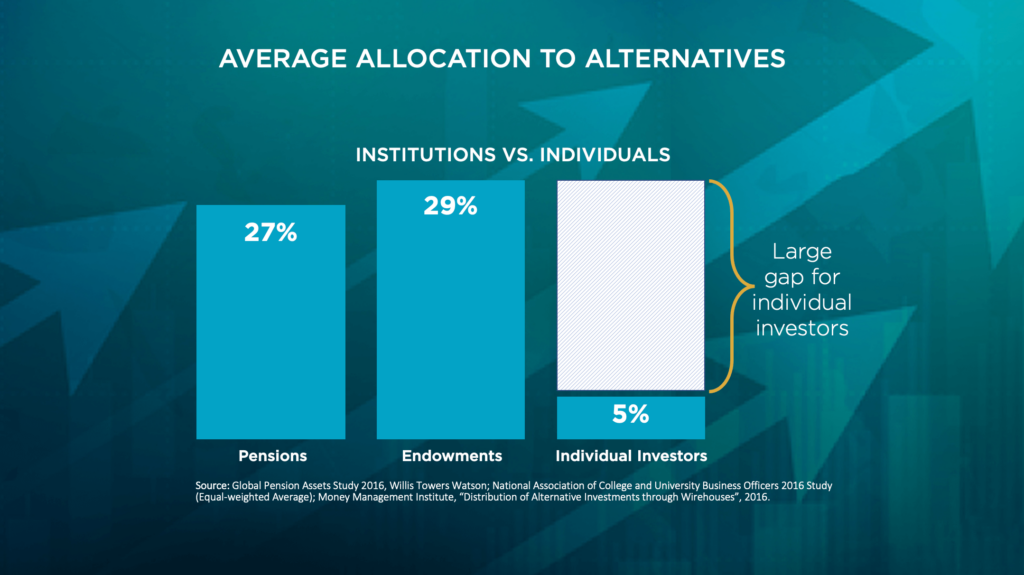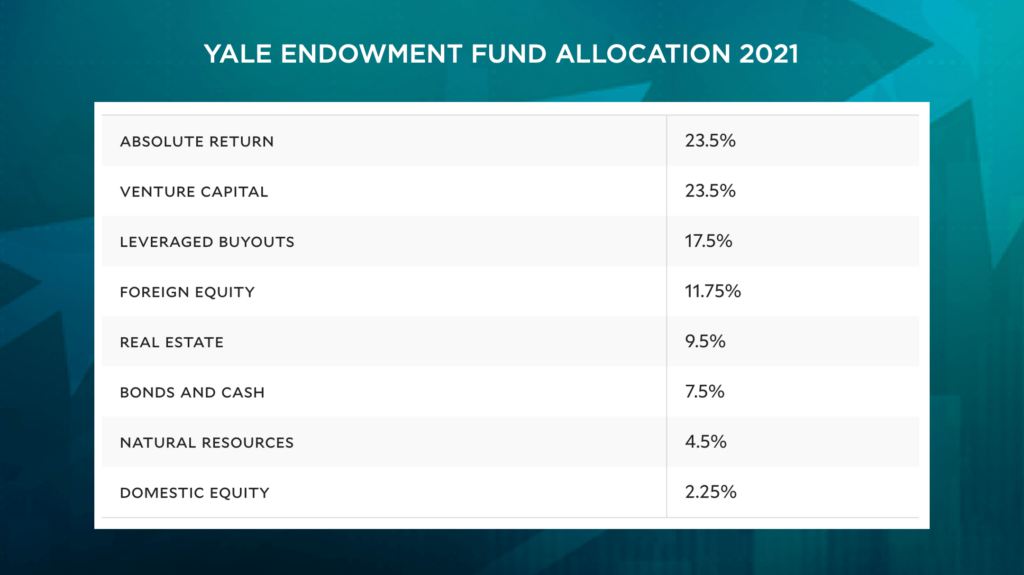What is an ‘Alternative Investment’?
The term ‘alternative investment,’ might bring to mind an investment that only large institutional investors have access to, or at least an investment that is generally too complicated for the average investor to understand. This is a common misconception, and until recently, may have been somewhat true. But, with recent regulation changes, access to this class of investments has opened up to a much broader audience and the benefits are far more advantageous than you might expect.
Precious metals, oil and gas, venture capital, hedge funds, and real estate are examples of alternative investments (also referred to as alternatives, alts, or class of investments). All alternative investments fall into one of two broad categories: public or private investments.
An alternative investment you’ve likely heard of are REITs, or real estate investment trusts. This is a common public alternative investment. Your financial advisor probably has mentioned them, and you may even have some REIT holdings in your portfolio. And while REITs can be an okay option, they miss a lot of the advantages of private alternative investments.
Many investors aren’t aware of the distinction, or the benefits of private alternative investments. However, private real estate funds significantly outperform REITs. We find the biggest gap in most investors’ portfolios are in private alternative investments, and that is what we are going to zero in on.
So, What Are the Benefits of Investing in the Alternative Asset Space?
If the average individual investor were to compare their investment allocations with the big guys, they’d find a massive difference.
Take a look at this data that highlights the disparity between how institutions (the big guys) and individuals invest.

The average institutional investor (hedge funds, family offices, endowments) has up to 30% of their portfolios in things other than stocks, bonds and mutual funds. These investments can be in real estate, venture capital, and hedge funds, among other things. Compare this with the average individual investor who is putting 95% of their money into the stock market.
While the public market (stocks and bonds) is not bad, these institutional investors know something regular investors don’t know about the benefits of alternative investments.
This is another interesting chart showing the investment allocations of the Yale Endowment fund. This fund is an interesting case study because many decades ago, Yale diverted money from just stocks and bonds into more alternative assets like hedge funds, real estate, and even timber. This grew the endowment from $1.3 billion in 1985 to $31.2 billion in 2020.

Yale has outperformed its domestic equity index (an index fund that invests in US stocks) by a good margin over the past few decades, hitting nearly a 10% annualized return over the last 20 years ending July 2020. During that time frame, the stock market return was 6.2%.
So if the wealthiest and most successful investors are investing large amounts of their portfolios into alternatives and seeing better returns, why aren’t regular investors doing this?
Well, up until 2012, before the Jobs Acts passed, individual investors didn’t have many options outside the public markets unless you had pre-existing relationships with the sponsors. But now because of the passing of this Act, accredited investors now have access to private investments that were previously reserved for bigger family offices, and institutional investors with relationships with private equity firms. Institutional investors have been investing in this asset class for decades, but now there are new avenues for individual investors to explore – and with some significant upside.
Different Types of Alternative Investments
Generally speaking, an alternative investment is something that is an “alternative” to stocks, bonds, mutual funds offered on Wall Street.
The most common types of alternative investments are: hedge funds, private equity, venture capital, oil & gas, and real estate. Some even extend the definition to gems and precious metals, art & antiques, and collectibles.
Here are some of the broadest categories of the most common alternative investments:
- Hedge Funds: these funds can invest in a wide range of securities and are generally limited to publicly traded investments. There are many different types of strategies, but usually the goal is to use their specific strategy to generate returns in both up and down markets.
- Venture Capital: these firms focus on investing equity into privately-owned companies. Generally, these companies are at an early-stage or startup level with rapid growth as the goal, and they eventually seek an exit either by acquisition of another company or by an Initial Public Offering (IPO).
-
Private Equity: this is probably the broadest category of the three, as it encapsulates all other private investments other than venture capital. Fund managers in this class can range from smaller million-dollar funds to multiple billions. The types of assets they invest in extend from real estate, to infrastructure, to oil & gas, to debt. Another large subset of private equity seeks to take controlling interests in operating businesses.
While hedge funds and venture capital investments do have many benefits for the investors that fit their criteria, the majority of investors will benefit more greatly from private equity alternatives, especially as that is where the greatest gap lies for most investors. Private equity alternatives are where we will concentrate our discussion.
6 Benefits of Alternative Investments – Why Invest?
1. Alts are Generally Uncorrelated to the Stock Market
Every investor who has been in the stock market for any length of time has likely experienced some big wins… and major losses. Anyone who is nearing retirement or currently retired has experienced the heartburn with watching their portfolio drop, sometimes in dramatic fashion.
Diversification is one of the main reason’s investors seek alternatives investments. In fact, a recent survey by iCapital Network of top U.S. investment advisors found diversification and attractive returns as two of the top reasons to invest in alternatives.
An investment that is uncorrelated to the stock market, means that it does not change relative to the ups and downs of the market. Many investors think they are diversified by holding REITS or other publicly-traded alternatives, only to find that they are just as volatile and don’t add much value to an investment portfolio.

And this is why we make the key distinction between public and private alternatives.
Many investors have discovered private alternatives as a way to protect against volatility, diversifying their portfolios. This way, when the stock market drops significantly, they have a hedge of protection and not all of their investment portfolio will be affected.
The stock market is famously unpredictable, even in a stable economy, and alternatives are largely shielded from the unpredictable swings in the public markets.
A great example is in real estate. Let’s say you are invested in mortgage notes or have a rental property. Even though the stock market has fluctuated significantly over the last few months, your borrower or tenant is going to keep paying their mortgage or rent.
2. Lack of Volatility
In a traditional public investment, the share price fluctuates based on a variety of factors (many times not directly tied to a company’s performance), but is generally not tied to an actual asset. Because shares of a private investment are not publicly traded, you avoid the volatility of public investments. Plus, your investment is also typically backed by a real asset.
Some may say that volatility is not a concern if you are a long-term investor, and despite the ups and downs of the stock market, it still averages ~6-8% over the long-term (depending who you ask). But what they don’t understand is that volatility kills compounding. Here’s a scenario that might change your mind.
Here are two examples showcasing two different outcomes where you initially invest $100,000 and let it grow over 30 years.
- In Scenario #1, you invest the $100,000 in the stock market. You have big gains, but also big losses (i.e. volatility). But, your “average” return over 30 years is 10%, not too bad, right?
- In Scenario #2 you earn a respectable, but rather vanilla 9% return per year, every year.
Albert Einstein once said, “Compound interest is the eighth wonder of the world.” Here is displayed the incredible power of consistent compounding.
Scenario #1:

Scenario #2:

Even though the “average” return was lower in the second scenario, because it wasn’t volatile, it was able to compound and the end result is over 6 times higher than the first scenario. This a dramatic illustration, but the point remains, volatility kills the power of compounding.
3. Direct Ownership
In most public investments, what you’re buying is a paper asset – the discounted value of future expected earnings. You don’t really own anything. Even if you invest in a REIT, you’re many levels removed from having your name on the deed of the real estate property.
If you are buying fine wine or art though, you directly own those bottles of wine or that oil painting. If you have bought a rental property, you directly own the home. If you buy a mortgage note, you have a lien against a property. Or if you invest in a private fund, generally have direct ownership of whatever asset they purchase.
In the case of Aspen’s Income Fund, all investors become part owners of a fund whose name is on the title deed of each mortgage it owns. In this way, if Aspen were ever to disappear, investors would still retain that ownership in the mortgage and the rights as a lender to the property. This is the beauty of alternative investment.
4. Direct Tax Benefits of Alternative Investments
Alternative investments can also provide compelling tax benefits. With many alternative investments you get to keep more of your profit because of the structure. In many private alternative investments, you become a part-owner of the fund or syndication and as such the tax benefits get directly passed on to you.
The two most important tax benefits are pass-through depreciation and long-term capital gains treatment. Many real estate funds or syndications deduct depreciation expense (a non-cash expense) from net income reducing taxable income. Oil and gas investments have very favorable depreciation/depletion tax treatment.
Aspen Funds uses pass-through LLCs of which investors become a part owner of. In our funds, a portion of the income is considered as long-term capital gains, which provides a very favorable tax treatment.
Many investors are also unaware that you can invest in private alternatives with qualified retirement funds, such as a 401K or IRA. Depending on how you structure the investment, you can grow your investment tax deferred or even tax free.
5. Alt Investments Provide a Strong Source of Income
Not all private alternative investments are cash-flowing investments (meaning, they pay you back in cash on a monthly or quarterly basis), but there are many that do, generally in a cash-flowing real estate strategy. Some can produce strong income, in the 8-10% range annually. Many funds are structured to have a preferred return where the investors get paid first, in cash.
Anyone who has tried to generate income from public investments, such as CDs, bonds or dividend paying stocks knows how difficult this can be. We routinely talk with investors who are struggling to generate cash flow in their portfolios, generally in the low single digits. As already discussed, the public markets can be very volatile, increasing the risk just to generate a small yield.
Read more about why cash flow may just be the most important feature to look for in investments.
6. Passive Investments
Most busy investors place a high value on their time, and actively managing an asset or portfolio requires an enormous amount of work.
Let’s take real estate as an example, as that is where most investors think to start actively investing. After getting excited about the prospect of purchasing a single-family home as a rental or even maybe, a small multifamily apartment, they quickly realize how much work is involved and how large the learning curve is.
There is an endless supply of educators that are selling their “5 Step Plan to Success”, but ultimately it is hard work – finding co-investors, obtaining financing, structuring the deal, finding and evaluating properties, etc. At this point, many investors give up and just assume that there aren’t any other options.

Again though, due to regulation changes, there has been growth as a whole new world of investments has opened up, many of which are completely passive.
For example, Aspen’s Funds are completely passive and don’t require any ongoing management from investors. The other advantage of truly passive funds or syndications is that you can leverage the expertise, team, and relationships of experienced operators.
Disadvantages of Alternative Investments
While private alternatives have many benefits, there are a few drawbacks. The most common roadblock for investors looking to get into alternatives is liquidity. If you’re investing into a private fund, most will have a lockup period anywhere from 3-10 years before you can withdraw your initial investment (though many pay out a return during the lockup period). This makes sense when you understand private funds are generally tied to an asset and to liquidate an investment requires liquidating the asset.
However, some classes of private alternatives, like note investing, can overcome this hurdle because there is an active secondary market. In our Income Fund, we have designed it to have only a 1-year lockup period with liquidity thereafter.
Another disadvantage is that many alternative investments require investors to be accredited; in other words, a high net worth investor. However, changes to regulation continue to open up more options to non-accredited investors, allowing more people to invest in alternatives.
Who Are Alternatives Right For (Who Should Invest in Alternatives)?
Alternative investments can be a great fit for any individual who wants to further diversify their portfolio.
Depending on your stage of life and level of interest in actively managing your investments, different alternative investing strategies will be more appealing. Let’s take a look at three common types of investor:
Active Investor
For the active investor looking to roll up their sleeves, many popular alternatives in real estate, as well as other industries, open up. Ideal alts for active investors include owning rental properties, flipping houses, or private equity with more of an active management approach.
Passive Investor
For the passive investor, alternatives can provide strong returns that won’t require additional time to manage. Alternatives that are ideal for this type of investor are private equity, mortgage note fund investing, collectibles and precious metals.
Retired or Income-Focused Investor
For those in or nearing retirement or looking for income, alternatives provide a low-volatility source of income, similar to dividend investing, allowing investors to replace or supplement their earned income or retirement income. Alternative investments that fit best for this type of investor will mostly fall within funds — private equity funds, private REITs, private real estate funds, etc.
If you’d like to learn more about our Income Fund, watch our free webinar for a deep dive into how the fund works and creates passive income.
Additional Reading
Why Cash Flow is King in Investing
Mortgage Note Investing Overview

 Private Equity: this is probably the broadest category of the three, as it encapsulates all other private investments other than venture capital. Fund managers in this class can range from smaller million-dollar funds to multiple billions. The types of assets they invest in extend from real estate, to infrastructure, to oil & gas, to debt. Another large subset of private equity seeks to take controlling interests in operating businesses.
Private Equity: this is probably the broadest category of the three, as it encapsulates all other private investments other than venture capital. Fund managers in this class can range from smaller million-dollar funds to multiple billions. The types of assets they invest in extend from real estate, to infrastructure, to oil & gas, to debt. Another large subset of private equity seeks to take controlling interests in operating businesses.

